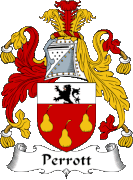PARLIAMENTARY P*RR*TTS
In the course of his research into Sir Richard Perrot, Bob Turner (member 2004) reviewed The Journals of the House of Commons from 1714 to 1787 for any P*rr*tt entries and found a number of items of interest.
GEORGE PERROT
George was the son of Thomas Perrot and Anastasia Plaxton, the grandson of Andrew Perrot and Martha Vanlys and the great-grandson of Richard Perrot and Dorothy Harris. This Perrot family resided in Yorkshire according to Banwell’s Perrot Notes, the accuracy of which has been discussed previously in Family Notes, Andrew Perrot had twenty children and Thomas Perrot had eleven children. George was educated at Westminster School, admitted to the Inner Temple in 1728 and called to the bar in 1732. He became a bencher of the Inn in 1757 and King’s Counsel in 1759. George retired in 1775 having been “seized with a fit of palsy” during the Lent assizes at Maidstone and thereafter received a pension of 1,200 pounds per year. According to the National Archives currency converter, this is the equivalent of just over £100,000 per year today, so quite a substantial sum. He married Mary Bower in 1742 but the couple left no children. In the accounts of monies paid by the Exchequer George is first listed as receiving £26 18s ¾d as “one of his Majesty’s Counsel at Law. A number of subsequent annual payments for his services in his capacity as Baron of the Exchequer are also recorded for varying amounts. George is also named as a petitioner in relation to a bill proposing the building of a canal between Coventry and Oxford and as a subscriber to ‘Thomas Hale’s Social Harmony’ (as is John Parrott of Middlewich in Cheshire). This was a book of songs for several voices in harmony which included a number of songs about masonry.
WILLIAM PARROT
In 1715 the custom house on Thames Street was destroyed by fire, resulting in the loss of stock belonging to several London merchants. The building was relatively new, having been built after its previous incarnation was destroyed in the Great Fire in 1666. William Parrot claimed the loss of a significant quantity of sugar. Parliament subsequently agreed – following some debate about amendments with the House of Lords – to “An [Private] Act for the Relief of Anne Milner, Thomas Colmore, William Hunt, William Parrot and others, as to customs of goods, burnt or destroyed by the late fire in Thames-Street, London”.
PHILIP PARROTT
Philip is named as a petitioner in relation to enclosures in the parish of Dorrington in 1787. There are two places called Dorrington in the UK – one in Shropshire and one in Lincolnshire. Most likely this refers to Philip Parrott who was born in Hatton, Lincolnshire in 1744, the son of John Parrott and Susannah Phillips. He married Mildred Jackson in Rand, Lincolnshire in 1767.
JOHN PERROT
John Perrott received payments from the Exchequer as “one of the Secondaries in the Remembrance’s Office in the Court of Exchequer”. He had begun his career as a Junior Sworn Clerk in 1753 and succeeded his brother George in 1762 as Third Sworn Clerk when George was promoted to be a Baron of the Exchequer. He subsequently became a Second Secondary in 1766 and finally reached the post of First Secondary in 1769 following the death of the previous incumbent. His ancestry is as per that of George Perrot on the previous page.
JOHN PERROTT
Another John who appears in the journal is John Perrott (1702-1776) the Lord of the Manor of Brians Bell in Belbroughton, Worcestershire. He is perhaps best known as the creator of Perrott’s Folly in 1758. He petitioned Parliament regarding enclosures in Belbroughton asking that “Leave may be given to bring in a Bill for dividing, inclosing, and allotting, the said Common or Waste Ground called Bell Heath, in the Manor of Brians Bell, in the Parish of Bellbroughton, in the County of Worcester aforesaid, unto and amongst the several Persons interested therein, in such Manner as the House shall seem meet”.
